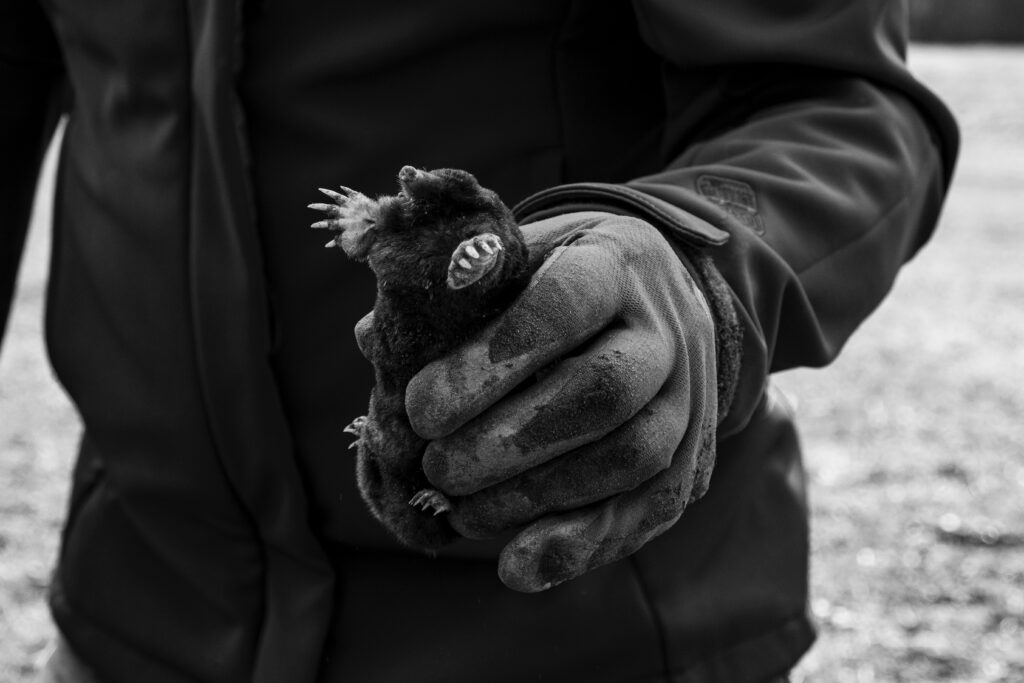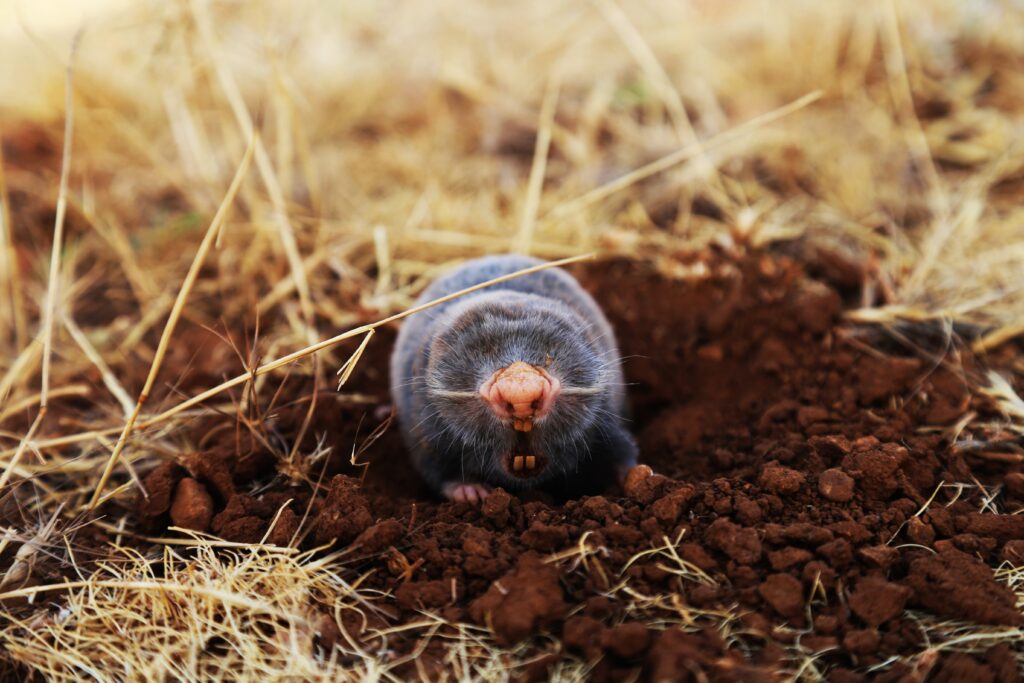
Learn about the differences between voles and moles, and discover how to identify, prevent, and deal with these common garden pests.
Table of Contents
Voles vs. Moles: What’s the Difference?
Voles and moles are both small burrowing mammals that can cause damage to your garden or lawn. While they might seem similar at first glance, they have distinct differences in their physical appearance, habitats, and behavior.
Voles
- Small, mouse-like rodents with short tails
- Typically 5-8 inches long
- Herbivores that feed on plants, roots, and bark
- Active above ground and make shallow burrows
Moles
- Small, insectivorous mammals with elongated, cylindrical bodies
- Approximately 4-9 inches long
- Eat insects, particularly earthworms and grubs
- Create extensive underground tunnel systems
What Do Voles Eat?
Voles, unlike moles, are primarily herbivorous, which means they feed on plant material. These small rodents have a diverse diet, consuming a variety of plants, roots, bark, seeds, and bulbs. Their feeding habits can cause damage to gardens, lawns, and even trees. Here is a breakdown of some common food sources for voles:
- Grasses and Ground Covers: Voles typically feed on a variety of grasses and ground covers, including turfgrass and other low-growing plants found in lawns and gardens.
- Roots and Tubers: Voles also eat roots and tubers of various plants, which can lead to the destruction of flower beds, vegetable gardens, and other cultivated areas.
- Bark: During the winter months, when food sources are scarce, voles will often chew on the bark of trees and shrubs, potentially causing damage or even death to the plants.
- Seeds and Nuts: Voles will also consume seeds, nuts, and other plant-based materials when available, which may include garden crops or even birdseed that has fallen to the ground.
- Fruits and Vegetables: Voles may eat fruits and vegetables in gardens, leading to crop loss for gardeners and farmers.
Voles’ feeding habits can cause significant damage to plants and landscaping, making them a common nuisance for homeowners and gardeners. In addition to their direct feeding damage, voles can also create unsightly runways and burrows on the surface of lawns and gardens, further contributing to their status as a problematic pest.
| Useful Amazon Products |
What Do Moles Eat?
Moles are primarily insectivorous, meaning they mainly consume insects and other small invertebrates. Although they are often mistakenly believed to be herbivores or plant-eaters, moles are actually carnivores with a specialized diet. Their preferred food sources include:
- Earthworms: Moles’ primary food source, they are attracted to areas with moist soil where earthworms are abundant.
- Grubs: Moles also eat the larvae of various insects, such as beetles, which are commonly referred to as grubs.
- Insects: In addition to earthworms and grubs, moles feed on a variety of insects such as ants, termites, and beetles.
- Small Invertebrates: Moles may also eat other small invertebrates, like snails, slugs, and centipedes, found in their underground tunnels.
Moles have a high metabolism and require a large amount of food to sustain their energy levels. They can consume up to their body weight in food each day. Moles’ consumption of insects and grubs can be beneficial for controlling some pests in your garden. However, their digging habits can also cause damage to lawns and gardens, which is why they are often considered a nuisance.
Identifying Voles and Moles
To determine if you have a vole or mole infestation, look for these signs:
Vole Signs
- Vole runways: Shallow, grassy paths on the surface of your lawn or garden
- Small, round holes: Entrances to their burrows
- Damaged plants: Voles chew on plants, roots, and bark
Mole Signs
- Molehills: Piles of dirt created by moles as they tunnel underground
- Raised ridges: Indicate the presence of mole tunnels
- Insect damage: Moles eat insects, so an increase in insect damage might signal a mole infestation

Preventing Voles and Moles
To prevent voles and moles from damaging your garden, follow these tips:
- Remove food sources: Keep your lawn free of debris and fallen fruit
- Mow your lawn regularly: Tall grass provides cover for voles
- Use fencing: Install hardware cloth around gardens and tree trunks to prevent voles from burrowing
- Encourage natural predators: Attract birds, dragonflies, and other predators to help keep pest populations in check
Dealing with Voles and Moles
If you’ve identified a vole or mole infestation in your garden or lawn, it’s essential to address the problem promptly to prevent further damage. This comprehensive guide will outline various methods for dealing with voles and moles effectively:
Dealing with Voles
- Trapping: One of the most effective ways to deal with voles is to use live or snap traps. Place the traps near active runways or burrow entrances, and bait them with peanut butter, oatmeal, or apple slices. Check the traps daily and dispose of any captured voles humanely.
- Repellents: Use commercial repellents specifically designed for voles, which typically contain capsaicin or castor oil. Apply these repellents to areas where voles are active, following the manufacturer’s instructions.
- Predators: Encourage natural predators, such as owls, hawks, and snakes, to help control the vole population. Install birdhouses and perches for birds of prey, and create habitat features like rock piles for snakes.
- Exclusion: Install hardware cloth or metal mesh around the base of trees, shrubs, and garden beds to prevent voles from chewing on bark or accessing plant roots.
- Habitat Modification: Reduce the attractiveness of your property to voles by mowing the lawn regularly, removing brush piles and debris, and eliminating ground cover that provides hiding spots.
Dealing with Moles
- Trapping: Use specially designed mole traps, such as scissor traps, harpoon traps, or choker loop traps, to capture moles in their tunnels. Place the traps in active mole tunnels, following the manufacturer’s instructions for proper setup.
- Repellents: Apply commercial mole repellents containing castor oil to your lawn and garden. These repellents can make the soil unpalatable to moles and encourage them to move elsewhere.
- Biological Control: Introduce beneficial nematodes or milky spore bacteria to your lawn and garden to control grub populations, which are a primary food source for moles. Reducing the availability of food may encourage moles to leave your property.
- Physical Barriers: Install underground fencing made of hardware cloth or metal mesh around your garden beds or other valuable landscaping features. Bury the fencing at least 12 inches deep to prevent moles from tunneling beneath it.
- Flooding: In some cases, you can flood mole tunnels with water to force them to the surface. This method is not always effective and may not be suitable for all situations.
When dealing with voles and moles, it’s essential to remain patient and persistent, as these pests can be challenging to eliminate entirely. If the infestation is severe or you’re unsure about handling the issue yourself, consider hiring a professional pest control service to assist you.
(Video) How To
FAQ
How do I know if I have a mole or a vole?
To determine if you have a mole or a vole infestation, look for specific signs. For voles, search for shallow, grassy runways on the surface of your lawn, small round holes that serve as burrow entrances, and damaged plants with chewed roots and bark. For moles, look for molehills (piles of dirt), raised ridges on the ground indicating tunnels, and increased insect damage in your garden or lawn.
Do moles or voles come out at night?
Both moles and voles are more active during the nighttime or at dawn and dusk. However, they can also be active during the day, especially in less-disturbed areas. Their activity may fluctuate based on the availability of food, weather conditions, and the presence of predators.
Why do I suddenly have voles in my yard?
Voles may suddenly appear in your yard due to several factors, such as an increase in food availability, suitable ground cover, or nearby construction that has disrupted their habitat. Voles are attracted to yards with abundant plant material, seeds, nuts, and other food sources. They also seek shelter in tall grass, ground cover, and brush piles.
What time of day are moles most active?
Moles are primarily active during the early morning and late afternoon hours. They can also be active at night, as their primary food sources, such as earthworms and grubs, are more abundant during these times. However, moles may be active at any time of day, depending on factors like weather, soil conditions, and food availability.
Can you touch a vole?
It is generally not recommended to touch a vole or any wild animal, as they may carry diseases or parasites that can be transmitted to humans. Additionally, handling voles can cause stress to the animal and may result in bites or scratches. If you need to remove a vole from your property, use gloves and appropriate tools like live traps to minimize direct contact.
For more tips and tricks on dealing with other common garden pests and wildlife, check out these articles:


